Maserati A6
Maserati A6 were a series of grand tourers, racing sports cars and single seaters made by Maserati of Italy between 1947 and 1956. They were named for Alfieri Maserati (one of the Maserati brothers, founders of Maserati) and for their straight-six engine.[1]
| Maserati A6 | |
|---|---|
 1956 A6G/54 Zagato Coupé Speciale | |
| Overview | |
| Manufacturer | Maserati |
| Production | 1947–1956 |
| Designer | Ernesto Maserati, Alberto Massimino and Gioacchino Colombo |
| Body and chassis | |
| Class | Grand tourer |
| Powertrain | |
| Engine | 1.5 L I6 2.0 L I6 |
| Transmission | 4-speed manual |
| Dimensions | |
| Wheelbase | 2,550 mm (100.4 in) |
| Chronology | |
| Predecessor | Maserati 6CM (racing cars) |
| Successor | Maserati 200S and 150S (racing cars) Maserati 3500 GT (road cars) |
The 1.5-litre straight-six was named A6 TR (Testa Riportata for its detachable cylinder head[2]), and was based on the pre-war Maserati 6CM; 65 bhp (48 kW). It first appeared in the A6 Sport or Tipo 6CS/46, a barchetta prototype, developed by Ernesto Maserati and Alberto Massimino. This became the A6 1500 Pinin Farina-designed two-door berlinetta, first shown at the 1947 Salon International de l'Auto in Geneva (59 made) and the spider shown at the 1948 Salone dell'automobile di Torino (2 made).
A 2-litre straight-six (120 bhp) was used in the A6 GCS two-seater, «G» denoting Ghisa, cast iron block, and «CS» denoting Corsa & Sports. Also called monofaro, the 580 kg single-seater and cycle-winged racing version first appeared at Modena 1947 by Luigi Villoresi and Alberto Ascari, and won the 1948 Italian Championship by Giovanni Bracco. Fifteen cars were made 1947-1953, of these being two-seaters (630 kg).
The A6G were a series of two-door coupe and spyders by Zagato, Pinin Farina, Pietro Frua, Ghia, Bertone, Carrozzeria Allemano and Vignale. These had alloy engine blocks.
Maserati A6 fitted 16" Borrani Wheels and Pirelli Stella Bianca Tyres
Introduction
The acronyms identifying each model are interpreted as follows:
- A6: the name of the series: A for Alfieri (Maserati), 6 for six cylinders.
- G: «Ghisa», cast iron, the engine block material.
- CS: «Corsa Sport», for racing sports car.
- CM: «Corsa Monoposto», for single seater racing car.
«1500» or «2000» indicate the rounded up total engine displacement in cubic centimetres; while suffixes such as «53» denote the year of the type's introduction.
A6 Sport

.jpg)
The Tipo 6CS/46, also called A6 Sport, were two prototype barchettas made early 1947 by Ernesto Maserati and Alberto Massimino. They used the 1.5-litre straight-six engines from the pre-war Maserati 6CM.[3] These took the first two places at Circuito di Piacenza on 11 May 1947, driven by Giulio Barbieri and Mario Angiolini.[4]
A6GCS
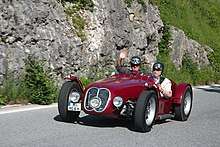
In 1947 Maserati developed a two-seater sports racing car powered by a 2.0-litre engine called A6GCS. At first it produced 120 hp but was further upgraded in 1952.[3]
A6 1500
| Maserati A6 1500 | |
|---|---|
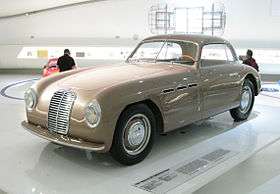 1947 A6 1500 Pinin Farina | |
| Overview | |
| Production | 1947–1950 |
| Powertrain | |
| Engine | 1.5 L I6 |
| Transmission | 4-speed manual |
The A6 1500 grand tourer was Maserati's first production road car. Development was started in 1941 by the Maserati brothers, but it was halted as priority shifted to wartime production, and was completed after the war.[5] The first chassis, bodied by Pinin Farina, debuted at the Geneva Salon International de l'Auto in March 1947. This first prototype was a two-door, two-seat, three window berlinetta with triple square portholes on its fully integrated front wings, a tapered cabin and futuristic hidden headlamps. The car was put into low volume production, and most received Pinin Farina coachwork. For production Pinin Farina toned down the prototype's design, switching to conventional headlamps; soon after a second side window was added. Later cars received a different 2+2 fastback body style. A Pinin Farina Convertibile was shown at the 1948 Salone dell'automobile di Torino, and two were made; one car was also given a distinctive coupé Panoramica body by Zagato in 1949, featuring an extended greenhouse. Sixty-one A6 1500s were built between 1947 and 1950, when it began to be gradually replaced by the A6G 2000.[5]
The A6 1500 was powered by a 1,488.24 cc (90.8 cu in) inline six (bore 66 mm, stroke 72.5 mm), with a single overhead camshaft and a single Weber carburettor, producing 65 hp (48 kW; 65 bhp); starting from 1949 some cars were fitted with triple carburettors.[5] Top speed varied from 146 to 154 km/h (91 to 96 mph). The chassis was built out of tubular and sheet steel sections. Suspension was by double wishbones at the front and solid axle at the rear, with Houdaille hydraulic dampers and coil springs on all four corners.
 First prototype by Pinin Farina
First prototype by Pinin Farina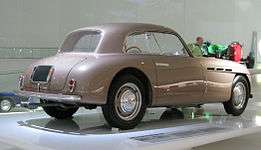 Rear view, early Pinin Farina body style.
Rear view, early Pinin Farina body style.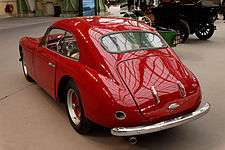
 The one-off A6 1500 Zagato Panoramica.
The one-off A6 1500 Zagato Panoramica.
A6G 2000
| Maserati A6G 2000 | |
|---|---|
_(15056472891).jpg) A6G 2000 Pinin Farina | |
| Overview | |
| Production | 1950–1951 |
| Powertrain | |
| Engine | 2.0 L I6 |
| Transmission | 4-speed manual |
The improved A6G 2000 began to replace the A6 1500 from 1950. The A6 engine was enlarged, precisely to 1,954.3 cc (119.3 cu in) with a bore and stroke of 72x80 mm; it retained the single overhead camshaft. Also thanks to triple carburettors, output was between 90–100 hp (67–75 kW; 90–100 bhp) and top speed 160 to 180 km/h (99 to 112 mph). The chassis retained the same measurements of the A6 1500, but the rear axle was now sprung on semi elliptic leaf springs.[6]
The model debuted at the 1950 Turin Motor Show, wearing Pinin Farina coachwork. Just sixteen cars were built, all between 1950 and 1951. Nine received 2+2 fastback bodies by Pinin Farina; Frua built five convertibles and one coupé; lastly one got Vignale coupé bodywork designed by Giovanni Michelotti.[6]
.jpg) 1951 A6G 2000 Pinin Farina
1951 A6G 2000 Pinin Farina.jpg) 1951 A6G 2000 Frua Spyder
1951 A6G 2000 Frua Spyder.jpg) 1951 A6G 2000 Pinin Farina, rear view
1951 A6G 2000 Pinin Farina, rear view.jpg) A6G 2000 engine
A6G 2000 engine
A6GCM
Maserati A6GCM (1951–53) were twelve 2-litre single-seater («M» for monoposto) racing cars (160-190 bhp), developed by Gioacchino Colombo and built by Medardo Fantuzzi. The A6 SSG (1953) was a GCM-revision pointing to the Maserati 250F.[7] It won the 1953 Italian Grand Prix driven by Juan Manuel Fangio.
A6GCS/53
| Maserati A6GCS | |
|---|---|
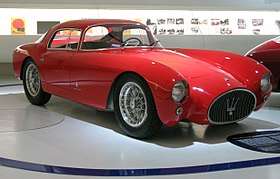 1953 A6GCS Berlinetta | |
| Overview | |
| Production | 1953-1955 |
To compete in the World Sportscar Championship, the A6GCS/53 (1953–55) was developed (170 bhp), spiders initially designed by Colombo and refined by Medardo Fantuzzi and Celestino Fiandri. Fifty-two were made. An additional four berlinettas and one spider were designed by Aldo Brovarone at Pinin Farina,[8] their final design of a Maserati for the next five decades, on a commission by Rome dealer Guglielmo Dei who had acquired six chassises.[9] Vignale also made one spider.
This car won the Polyphony Digital Award (an award given by Kazunori Yamauchi, creator of Gran Turismo game series) at the Pebble Beach Concours d'Elegance in 2014 and has been featured in the 2016 game Forza Horizon 3 as a special barn-find car, as well as the 2018 game Forza Horizon 4.
 1953 A6GCS/53 spider-bodied by Fantuzzi
1953 A6GCS/53 spider-bodied by Fantuzzi Maserati A6GCS
Maserati A6GCS 1954 Maserati A6GCS Berlinetta at the Goodwood Festival of Speed
1954 Maserati A6GCS Berlinetta at the Goodwood Festival of Speed 1954 Maserati A6 GCS at the 2011 Mille Miglia
1954 Maserati A6 GCS at the 2011 Mille Miglia
A6G/54
| Maserati A6G/54 2000 | |
|---|---|
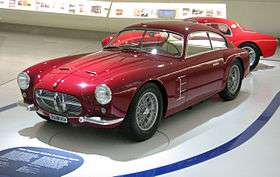 1956 A6G/54 Zagato | |
| Overview | |
| Manufacturer | Maserati |
| Production | 1954–1956 |
| Powertrain | |
| Engine | 2.0 L I6 |
| Transmission | 4-speed manual |
After a two-year hiatus at the 1954 Mondial de l'Automobile in Paris Maserati launched a new grand tourer, the A6G 2000 Gran Turismo—commonly known as A6G/54 to distinguish it from its predecessor.[10] It was powered by a new double overhead camshaft inline-six, derived from the racing engines of A6GCS and A6GCM, with a bore and stroke of bore 76.5x72 mm for a total displacement of 1,985.626 cc (121.2 cu in). Fed by three twin-choke Weber DCO carburettors it put out 150 hp (112 kW; 150 bhp) at 6000 rpm, which gave these cars a top speed between 195 to 210 km/h (121 to 130 mph).[10] Dual ignition added in 1956 increased power to 160 hp (119 kW; 160 bhp).[10]
Four body styles were offered: a three-box Carrozzeria Allemano coupé (21 made, designed by Michelotti), a coupé and a Gran Sport Spyder by Frua (7 and 12 made), and a competition-oriented fastback by Zagato (20 made). Total production between 1954 and 1956 amounted to 60 units.[10] An A6G/54 Zagato chassis 2155 received a unique coupé bodystyle, after being crashed on a test drive by Gianni Zagato. Distinguished by non-fastback rear-end and 'eyelids' over the headlights. It is also one of only two with a 'double bubble' roof.[11]
 1956 A6G/54 Allemano coupé
1956 A6G/54 Allemano coupé.jpg) The engine from the same car, showing dual ignition.
The engine from the same car, showing dual ignition..jpg) 1955 A6G/54 with Frua coupé coachwork
1955 A6G/54 with Frua coupé coachwork- 1956 A6G/54 Gran Sport Frua Spyder
 1956 A6G/54 Zagato
1956 A6G/54 Zagato
References
| Wikimedia Commons has media related to Maserati A6. |
- maserati-alfieri.co.uk on the A6.
- Papaidis, Vasileios. "1947/50 Maserati A6 1500 GT 3C Pinin Farina". Historic Automotive Promotion. Vasileios Papaidis. Retrieved 11 January 2017.
- "1954 Maserati A6 GCS". conceptcarz.com. Retrieved 19 December 2019.
- LOT 261: A 1948 Maserati A6 1500 GT Berlinetta, an auction report at maserati-alfieri.co.uk, last accessed on September 12, 2019.
- "Maserati 1500 Gran Turismo". maserati.com. Retrieved 9 June 2019.
- "Maserati 2000 Gran Turismo". maserati.com. Retrieved 9 June 2019.
- A6GCM Specification Archived 2007-04-30 at the Wayback Machine from maserati.org.au.
- "Aldo Brovarone meets his Maserati A6GCS/53 Berlinetta". autodesignclub.com. Archived from the original on May 24, 2015. Retrieved December 13, 2015.
- "Maserati A6GCS Berlinetta Pinin Farina". maserati.com. Retrieved 9 June 2019.
- "Maserati 2000 Gran Turismo (54)". maserati.com. Retrieved 9 June 2019.
- "Maserati A6G/54 2000 Zagato Coupe Speciale". ultimatecarpage.com. Retrieved 9 June 2019.